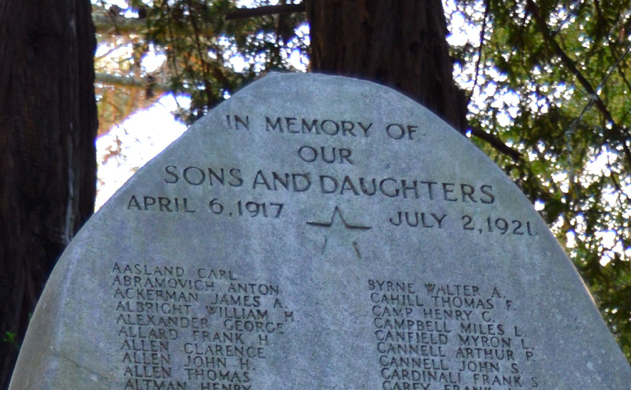
This year is the 100-year anniversary of the entry of the United States into World War I. It is also the 100-year anniversary of the Russian Revolution, at root an open mutiny against that war.
Hidden away in Heroes Grove, an almost-forgotten part of Golden Gate Park, is the Gold Star Mothers Rock. This monument is a memorial to U.S. veterans who died in World War I, and has a surprising relevance to the Russian Revolution.
The Great War
World War I began in 1914. Known at the time as the Great War, it became the most brutal and destructive war in history, up to then. Millions of soldiers and civilians died. It was a barbarian struggle by the imperialist powers of Europe – Britain, France and Germany chief among them – over their respective spheres of influence in Europe and control of their colonies in Africa and Asia. If there ever was a “rich man’s war” that was in reality “a poor man’s fight,” this was it.
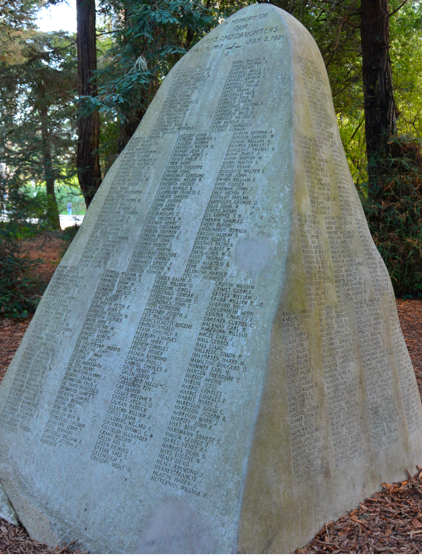
On the eastern front, the decrepit Czar Nicholas II allowed Russia to be dragged into the war on the side of Britain and France. Russia’s troops, poorly led and even more poorly equipped, were killed and wounded by the millions. In March 1917, a spontaneous revolt against the war spread throughout the country. The Czar was forced to abdicate and a new “provisional government” attempted to take power.
President Woodrow Wilson, who had won re-election in 1916 by promising to keep the U.S. out of the war in Europe, went before Congress in April 1917 and demanded a declaration of war against Germany. Congress obliged and declared war on April 6, 1917.
Before Wilson’s “war to end all wars” was over, well over 100,000 U.S. soldiers died. At least twice as many were wounded. Over four million soldiers were mobilized, despite widespread opposition to the war and the draft.
In October 1917, with the Great War still raging, the Russian people rose up again. This time they overthrew the “provisional government” that had maneuvered to continue Russian participation in the war. The Russian people had had enough, and put the Bolsheviks – firm opponents of the war – in power.
The slaughter of the Great War ended when a revolt spread throughout Germany, forcing the Kaiser to abdicate. Germany surrendered on November 11, 1918. The war officially ended in June 1919, with the signing of the Treaty of Versailles. We know now that this treaty only laid the basis for the even greater slaughter of fascism and World War II, and the wars that followed.
Heroes Grove
On Memorial Day on May 30, 1919, thousands of people gathered in Golden Gate Park to dedicate a 15-acre plot as the “Grove of Heroes,” in remembrance of the U.S. dead and wounded in the Great War. Many of the estimated 12,000 mourners were dressed in black. The mourners created what the San Francisco Chronicle described as a “towering obelisk of flowers and wreaths.”
The Chronicle also reported that Mayor James “Sunny Jim” Rolph “committed the grove to the protection of the United States Army, Navy and Marine Corps.” Officers of the Army, Navy and Marines accepted that charge.
Today, there are no markers to tell the visitor to the park where or what Heroes Grove is. There is a dirt footpath through the grove, but the only signs are a couple of “Stay on Path” warnings.
On Armistice Day (now known as Veterans Day) on November 13, 1932, there was another assembly in Heroes Grove. This time the gathering was to dedicate a new monument to U.S. war dead. The monument is an 18-ton granite boulder, reportedly quarried from Twin Peaks. The monument is inscribed with the names of 748 men and 13 women, all local soldiers and volunteers who died in the Great War.
Before the list of names is a simple inscription that reads:

The fighting in the Great War supposedly ended in 1918. The Treaty of Versailles was signed in 1919. So what does the 1921 date on the Gold Star Mothers Rock mean? More on that later, along with its relevance to the Russian Revolution.
So, where are Heroes Grove and the Gold Star Mothers Rock?
Transport yourself to Fulton Street and 10th Avenue. Here you will find the entrance to the park’s underground parking lot (a controversial pet project of the late Warren Hellman of Hardly Strictly Bluegrass fame). Behind the sign to the parking lot you will find an obscure, unmarked and unpaved footpath. This path will lead you into Heroes Grove.
Alternately, you can walk along the paved path on the north side of John F. Kennedy Drive, the northern road through the park, until you look down into the drive into the garage. Across the street is the obscene de Young Museum tower. Just to the west of the drive into the garage you will find another unmarked, unpaved footpath that will also lead you into Heroes Grove.
Whichever way you enter the grove, a little way along the path, look to your left. There you will see the Gold Star Mothers Rock.
You could walk along Fulton Street or John F. Kennedy Drive and just barely glimpse the Gold Star Mothers Rock through the trees, if you pay close attention. Thousands of people pass by every week and never notice. Think on that. This is a memorial to 761 people who died in World War I. Heroes, or perhaps victims, in the “war to end all wars.” This is their public marker. This is the glory that they have been granted.
You can also find the Gold Star Mothers Rock from an even more obscure, informal, unpaved footpath that enters the park from Fulton across from 11th Street, if you do not want to be bothered with any unnecessary steps through Heroes Grove.
My grandfather on my mother’s side fought in the Great War. I have heard stories of gas attacks, and of him floating in the Atlantic awaiting rescue after his ship was sunk. He is long gone, and I don’t know what was true and what was not. He was from Illinois, so he was never a candidate for the Golden Gate Park monument, and in any event he survived. If he had not, I would not be writing this. If my grandfather had not survived, my mother would not have married another veteran, who served honorably in the next war, that one a just and necessary fight against fascism. He also survived and amazingly enough is still alive today at the age of 100.
Nor, if my grandfather had not survived, would I have had an opportunity to tell the masters of war to go to hell when they attempted to put a gun in my hand and send me to Vietnam. War seems to have been the constant in the 20th century, and looks to be the same in the 21st.
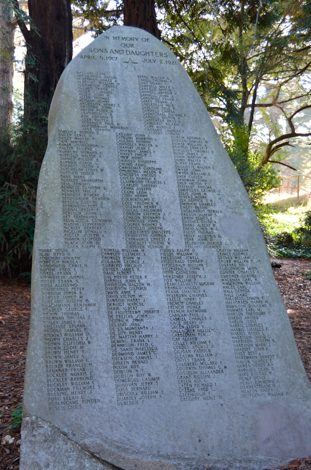
Once you have spent some time with the Gold Star Mothers Rock memorial, remembering the veterans of World War I, you can return to the footpath, and continue west. You will walk through the forest for a little distance, and perhaps (or perhaps not) heed the warnings to stay on the path. Eventually you will come to the end of Heroes Grove and encounter the freeway-like Park Presidio Bypass Drive through the park. Here you can exit Heroes Grove, turn left and enjoy the Rose Garden, a much better-known and more-accessible feature of the park.
The doughboy statue
After passing through the Rose Garden you can return to the John F. Kennedy Drive path, and walk on until you come to the Redwood Memorial Grove, across from the entrance to Stow Lake. In a clearing to your right you will see a more prominent World War I memorial, the Doughboy statue.
The Native Sons and Daughters of the Golden West planted 39 saplings and this statue in 1930, to commemorate some of the U.S. soldiers who died in the Great War, and in the Spanish-American War (the 1898 war in which the U.S. took possession of the Philippines, Guam, Cuba and Puerto Rico). The 39 saplings matched the 39 names memorialized on the plaque below the statue, all of whom were members of the Native Sons. This is a subset (not counting the Spanish-American War dead) of the hundreds of dead memorialized two years later on the Gold Star Mothers Rock.
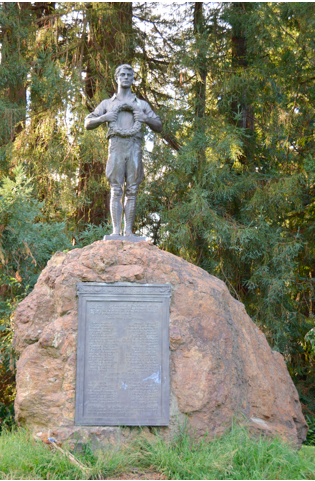
In 1951, the names of 16 members of the Native Sons who died in World War II were added to the Doughboy plaque. No one has added any names of the many dead from the many wars the U.S. has fought since the end of World War II. I expect that there were some Native Sons killed in Korea, Vietnam, Iraq and Afghanistan.
You can now retrace your steps back to the de Young Museum tower. You can enter the tower for free. From the 9th floor, you can look out to the north over Heroes Grove. But, unless you already know what you are looking for, you will have no idea what you are looking at. There is nothing in the tower that even hints at the existence of Heroes Grove right below your feet. Nor can you see the Gold Star Mothers Rock from the tower, as it is hidden below the trees. After you enjoy the view, you can go downstairs and spend umpteen bucks to look at art from all over the world.
U.S. fights the Russian Revolution
If you go back the same way you came, and pass by the Gold Star Mothers Rock again, you can contemplate why the inscription marks the end of the Great War as July 2, 1921.
The reason is that the U.S. Senate refused to ratify the Treaty of Versailles. Many senators were opposed to U.S. participation in the League of Nations, the forerunner of the United Nations, that was established by the treaty. The result was that it was not until 1921 that Congress passed a resolution officially ending U.S. participation in the war. President Warren G. Harding signed that resolution on July 2, 1921.
This would be only a historical footnote but for the fact that some U.S. troops continued to fight long after Germany had surrendered. But they weren’t fighting Germany. They were fighting Russians, in a useless attempt to overthrow the new Russian government and defeat the Bolsheviks. Wilson ordered two strategic armed interventions against the Russian revolution.
One such intervention has been dubbed the Polar Bear Expedition. A force of 5,000 troops were landed at Archangel in Northern Russia in September 1918, in support of British and French expeditionary forces that hoped to raise a White Army to defeat the Red Army organized by the Bolsheviks, and restore the eastern front. Some sources report that up to 8,000 U.S. troops were ultimately involved. It soon became obvious that the mission would fail, but the U.S. continued fighting through July 1919. Estimates are that nearly 250 U.S. troops died in this campaign.
The other intervention was in Siberia, the extreme eastern part of Russia. Here another 8,000 U.S. troops fought – along with troops from Britain, Canada, China, Italy and Japan – in the same vain attempt to kill the Russian Revolution in its infancy. This campaign started in August 1918, and went on until April 1920. Close to 200 U.S. troops died on this futile battlefront. Japanese troops stayed on fighting the Red Army until late 1922.
You don’t hear about Wilson’s war on Russia in your history class. If it were taught, it would help to explain the Russian Revolution’s antipathy to the U.S. and the Western powers in general. But, no, we learn instead that the U.S. represents the good guys and the Russians the bad guys, then and forever.
Were any of the U.S. soldiers killed in these Russian campaigns from the environs of San Francisco? Do their names appear on the Gold Star Mothers Rock? I don’t know. Maybe some family members know, or used to know. Maybe in this day of the Internet somebody could research the 761 names on the memorial and find out.
But what matters is that the 1921 date on the Gold Star Mothers Rock takes on a new meaning because of these failed interventions. The Great War did not end in 1918, or even in 1919. It went on in a very literal sense. Soldiers died, Russians died, and the unremitting hostility of the U.S. toward the nascent Soviet Union led to many thousands and millions more deaths – enough for many, many more Gold Star Mothers memorials.
War memorial veterans monument
The mothers who instigated the creation of the Gold Star Mothers Rock had hoped that the monument to their sons and daughters would be installed at a place of prominence in the city, specifically on Van Ness Avenue between the War Memorial Opera House and the War Memorial Veterans Building. Cornerstones for both of these buildings were laid in 1931, and the buildings themselves completed in 1932. The expansive open space between these two buildings must have seemed like the obvious and natural place for the Gold Star Mothers Rock.
But, as ABC Channel 7 news later put it, “money and other priorities got in the way.”
There is an unsigned, undated, two-page lament in the archives at the San Francisco Public Library that reads in part:
“There is another memorial spot set aside for the veterans of 1917-1918 which I visit on Memorial Day… We start at 10th Avenue and take a horse path going west among a group of trees. We proceed about 100 yards and presently to our left is a block of stone… [I]s this not a strange place for such a memorial?
“Surely their mothers, who brought them into the world, did not select this place on a horse trail in Golden Gate Park… Originally, when the Golden Star Mothers contracted for this memorial and paid for it, the idea for its final resting place was the beautiful little park on Van Ness avenue between the War Memorial Opera House and the Veterans of World War I Building…
“The Gold Star Mothers naturally assumed that since the citizens of San Francisco had voted bonds to the amount of five million dollars to erect these two buildings as a joint memorial to their sons and daughters, their memorial would be welcome.
“But it was not to be. It seems the powers then in authority ruled that the Veterans Memorial did not want it, and said so. They declared it crude and inartistic. By no stretch of the imagination could that unsightly block of granite conform to the artistic pattern of these two gems of architecture. The poor little broken-hearted mothers evidently had no friends to plead their case, and so their precious little memorial was trucked off to the park and there it rests.”
It was another 82 years before the “powers in authority” got around to placing a memorial to veterans in the space between these “two gems of architecture.”
In 2014, a memorial was dedicated after a private fund-raising campaign led by none other than Ronald Reagan’s former Secretary of State George Shultz.
Prior to going to work for Reagan, Shultz was President of Bechtel Corporation, the country’s largest construction and engineering company, which does business in every corner of the world. Bechtel, a private firm based in San Francisco, is widely considered a war profiteer for reasons far too numerous to detail in this article.
Shultz presided over the Reagan administration State Department from 1982 to 1989, throughout the period of the Reagan administration’s support for the illegal and savage Contra war against the Sandinistas in Nicaragua, who had overthrown dictator Anastasio Somoza Debayle. Shultz returned to the Becthel Corporation as a director and senior counsel after he retired from the State Department. Schultz was an early and strong backer of George W. Bush’s campaign for the Presidency, and actively supported his 2003 invasion of Iraq. In 2012, the American Academy in Berlin awarded Shultz with the prestigious Henry A. Kissinger Prize.
The words “war criminal” easily come to mind when thinking about Schultz.
According to San Francisco’s El Tecolote newspaper, $1.5 million of the $2.5 million raised by Shultz for the 2014 veterans memorial came from the Stephen Bechtel Fund. Stephen Bechtel is currently the co-owner of the Bechtel Corporation. El Tecolote called this “blood money.”
The understated new veterans memorial sits on the eastern end of an expanse of grass, facing City Hall. There are no names of any veterans, alive or dead, on the memorial.
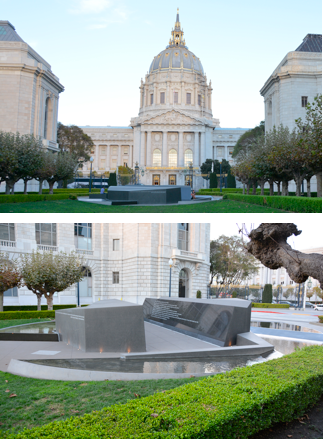
Actually there is the name of one veteran on the memorial, that of Archibald Macleish. Macleish was a poet and writer who saw action in World War I. He later found himself in the crosshairs of J. Edgar Hoover and his pal Joseph McCarthy. Macleish’s name appears under a poem inscribed in the center of the memorial, titled “The Young Dead Soldiers Do Not Speak.
As Macleish says in his poem, “Our deaths are not ours; they are yours; they will mean what you make them.”
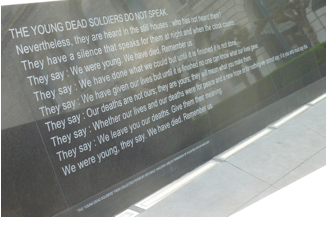
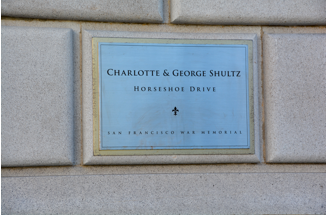
And so the “powers in authority” have chosen to give meaning to these deaths by naming the drive that surrounds this memorial on three sides the “Charlotte and George Shultz Horseshoe Drive.” This is certainly as ironic a memorial as naming Embarcadero Plaza after the racist Justin Herman. But unlike that tragic name, Shultz Horseshoe Drive remains like a bleeding scar in the heart of San Francisco.
Between the veterans memorial and Franklin Street lies an open sward of green grass. On the other side of Franklin Street is the eastern end of Fulton Street. It is a nearly-straight shot of about three miles up Fulton to the Gold Star Mothers Rock, hidden and nearly forgotten.
We forget the soldiers who have died in U.S. wars at our peril, and at the peril of the lives of our sons and daughters.
The grassy area next to the War Memorial veterans monument seems to be used these days primarily as a dog park. There is plenty of room on the grass there for the Gold Star Mothers Rock, which actually has names of veterans who died in the “war to end all wars.” Maybe someday the “powers in authority” will acquire the political will to move the Gold Star Mothers Rock memorial to the place where it should have been for these last 85 years.
Marc Norton’s website is www.MarcNorton.us.


Here is an interesting comment emailed to me by a reader:
“Thank you… 50 years ago, we wondered about the remote location when we held vigil there during the so-called ‘Summer of Love.’ Vietnam was not a distant memory… friends died there.”
You are most welcome.
You are right. As originally written, the article began “This is the 100-year of the entry of the United States into World War I,” meaning this year. Somehow that got mangled. You might note that later the article correctly states that World War I began on April 6, 2017. I will ask correct Tim to correct the error.
Good to know thank you!
“but not by murder”? Gimme a break. While it is true Stalin didn’t have crematories, there are plenty of pits with his victims and their bullet wounds.
And people didn’t “starve” – they “were starved”, by purposeful policies put in place to that effect.
Mao.
Pol Pot.
And plenty of other creeps who didn’t happen to subscribe to a lefty agenda (though that was the instigation of this sub-tread)
I’m not going to take away any of Hitlers disturbing “uniqueness”. But I do believe that the Jewish people are an ethnic group and not a “race” – even though he may have claimed they were.
Yes, many millions died under Stalin, but not by murder. People starved, or imprisoned,but there were not mass extermination camps like the Nazis engaged in. I have see more than a few right wing types try to claim that Stalin, or Mao were far worse than Hitler. Stalin and Mao were both monsters, but they did not set out to destroy an entire race of people.
The Spanish solution didn’t occur in wartime nor was it implemented by a military effort. It wasn’t a war crime. It was a Government(Monarchy) policy implemented by domestic security forces directed by their ideological leader(the Church). Native American relocation was US policy to clear the land of impediments to citizens occupying the land and solidifying US territorial claims. It wasn’t murder as understood by the policy makers and US public at the time. Similarly, “clearing” a lot for development today by removing the plants and animals that live there isn’t understood as killing. Both Spanish and US policies were “successful” in that they fulfilled the intent of the policy of the nation. As I’ve already written “Not defending or excusing Germany’s policy of ethnic cleansing at all.”
“sounds as though you are trying to defend Hitler”
Leave it to GG to put words in someone’s mouth, eh?
What I said (or tried to say) is to defend, left-handedly as it were, Wilson for opposing the Bolsheviks (and Wilson was by no means clean). Stalin (and Lenin by default) killed something like 30 million in 30 yrs of power. Mao … more like 50 million in 25 yrs. Pol Pot killed 1.5 million in 3 yrs. Stalin’s scapegoating (and killing) of the “Kulaks” may not have relied on centuries of church-sanctioned bigotry, but could almost be looked at as an example for others (Herr Butcher?) to later follow.
First sentence: “November 11, 2017 is the 100-year anniversary of the entry of the United States into World War I. “
What you are calling the Spanish “solution” was basically a war crime, as was the removal of Native Americans. For example, Andrew Jackson was, by definition, a war criminal. He took the land that belonged to the sovereign nation of the Cherokee people in Georgia. He did this in DEFIANCE of a ruling by the U.S. Supreme Court, basically saying, “let them try to enforce it.” It was, effectively, murder as many died on the Trail of Tears. Calling these things remotely successful is outrageous. They were acts of terror. The attempt by Germany to relocate Jewish people was not as serious as the decision to exterminate them, but was rooted in the same evil that drove the Holocaust. The fact that other countries would not take the refugees is, in no way, a justification or mitigation of the crimes committed by the Nazis.
Yes, but don’t forget that before the Final Solution there’s were other “more benign” solutions consisting of deportation/forced expulsion. Quite similar to the mostly successful Spanish “solution” of 1492 and the resettlements of Native Americans of the 1800’s. But the 1933 German expulsion solution failed mostly because other nations weren’t willing to accept all the German refugees/immigrants on offer. After 1939, with armies marching, and Jews in occupied(conquered) territory, deportation was no longer even a possibility. Not defending or excusing Germany’s policy of ethnic cleansing at all. Pointing out only that other nations were sympathetic to seeing Jews as a problem and sought to keep them Germany’s problem.
Yes, there are several in England. And there also several in the United States. One is at the Peace Abbey in Millis, MA, And there are plans for a museum to be added at the Presidio here in San Francisco. Here is a link to a site that list various ones around the world:
http://peace.maripo.com/p_co.htm
That is a good question.
Marc, please extend to your father my deep and heartfelt thanks for his service in World War II. They truly were our “greatest generation.
It almost sounds as though you are trying to defend Hitler and the Nazis. The so-called “Final Solution” was a deliberate act of genocide designed to eliminate certain groups from the face of the earth. Are you actually saying that they committed crimes of the magnitude of murdering six million Jews, as well at the gypsies, homosexuals, Jehovah’s Witnesses and others killed by the Nazis? I don’t wish to minimize what Lenin and Stalin did. They engaged in horrific crimes as well, as did Mao, and other communist leaders, but to attempt to imply that Hitler and the Nazis “were not that bad,” is outrageous. But it is a common claim of the alt-right.
And what exactly is the “factual error?”
11/11/18 is the date the Armistice was signed “eleventh hour, eleventh day, eleventh month” (though good pt about the signing of the peace treaty in ’21). Congress declared war, however, on 4/6/1917; so that is the effective date of its beginning.
I hope there aren’t any more factual errors.
A lot of American military history is shadowed and unspoken, glossed over in school textbooks. While MN makes a big deal out of Wilson’s efforts against the Bolsheviks, in retrospect, Lenin and Stalin were greater killers than Hitler, so maybe not so far treacherous an opposition after all. Still, its something that shouldn’t be clouded or shadowed.
Then there definitely SHOULD be a C.O. memorial. Are there any in existence?
World War I provided our rulers with an excuse for a massive campaign of repression against radicals and the forces of social justice. The legal basis for this campaign was laid with the passage of the Espionage Act in June 1917. The law carried specific prohibitions against opposing the draft and military recruitment, and criminalized support of “enemies” of the state. This law is still on the books. Some individuals charged under this act include Eugene Debs, Victor Berger, Emma Goldman, Julius and Ethel Rosenberg, Daniel Ellsberg, Chelsea Manning and Edward Snowden, among many others less well known.
The Swarthmore College Peace Collection contains a large number of primary source documents on conscientious objection during World War I. There were numerous religious objectors, along with political objectors including socialists and members of the International Workers of the World (IWW).
From the website of the Swarthmore College Peace Collection:
Conscientious objectors “were sent to military camps where they had to convince officers and other officials that they were sincere… One unofficial source states that 3,989 men declared themselves to be conscientious objectors when they had reached the military camps: of these, 1,300 chose noncombatant service; 1,200 were given farm furloughs; 99 went to Europe to serve with the Friends Reconstruction Unit; 450 were court-martialed and sent to prison; and 940 remained in the military camps until the Armistice was fully enacted in 1918. Recent scholarship, though, has revealed that the number was closer to 5,500 (at least), not counting the men who immediately signed up to go into the noncombatant branches of the military rather than declaring themselves to be conscientious objectors. [There were, of course, many others who found less legal methods of draft resistance.-MN]
“The absolutist C.O.s who refused to drill or carry out any noncombatant service were sentenced to many years of hard labor in federal prison at Alcatraz Island or Ft. Leavenworth U.S. Disciplinary Barracks, often suffering persecution, manacling, and solitary confinement. Most C.O.s who had been imprisoned were released by May of 1919, though some of those thought to be the most recalcitrant were kept until 1920. At least 27 C.O.s died, mostly while in prison.”
Maybe there could be a conscientious objectors memorial as well.